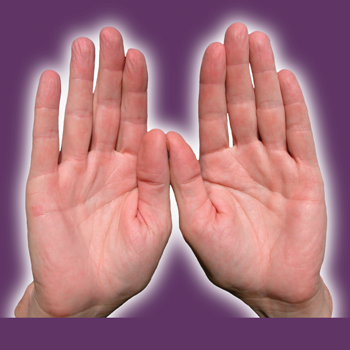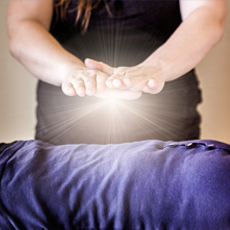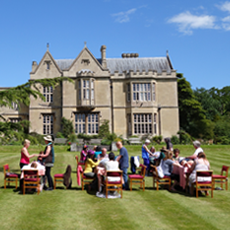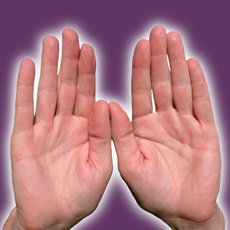by Brian D. Dailey, M.D., FACEP, FACFE
On December 3, 2003, I had the great pleasure of doing a hands-on workshop on Reiki at the University of Rochester School of Medicine & Dentistry. This was the second year we were invited for Hands-on CAM (Complementary & Alternative Medicine) sponsored by WISH (Wellness through the Integration of Science & Healing). Times have changed for the better! As a medical student at the University of Rochester in 1977, there were no CAM courses I could take, nor was my interest in CAM encouraged. Today there are CAM courses and electives available, and faculty to teach them. I have had medical students take electives with me, getting their Reiki certification and attending our Reiki circles. The Hands-on CAM is designed to acquaint medical students and faculty with a variety of complementary therapies, which they experience in hands-on sessions. It allows abstract concepts to be experienced and become real—a knowing rather than a belief.
In the PowerPoint presentation preceding the hands-on portion, we reviewed the concept of “energy medicine” (1-6). The energy body is the scaffolding that the physical body is built on, or modeled after. Einstein used E=mc 2 (energy=mass x velocity of light squared) to explain how energy and physical matter could be converted back and forth, that energy was neither created nor destroyed (even persisting after death). Disease is the result of imbalance, or asymmetry in the body’s energy field. The chakra energy system consists of seven major energy centers in the body’s midline, from the pubic bone to the top of the head, as well as thousands of smaller centers. The chakras allow energy exchange between the outside environment and the physical, mental, emotional, and spiritual body. Reiki is a powerful way to allow this energy exchange to occur and allow healing on these many levels. Reiki has been shown to induce a relaxation response in as little as five minutes, significantly reduce pain (7), and accelerate healing (5, 6). It is useful for treating many psychosomatic illnesses and autonomic dysfunction (e.g. fibromyalgia, phantom limb pain) often difficult to treat by conventional means. Twenty years ago few in the medical establishment were familiar with these concepts, but that night many of the participants raised their hands when questioned if any were familiar with these ideas. Modern medicine is now acknowledging that healing takes place on more than just the physical level, a major shift in thinking.
As a third degree Reiki Master, I have had the opportunity to teach Reiki and do workshops with both medical personnel (physicians, nurse practitioners, physician assistants, nurses, etc.) as well as lay people. One of the great beauties of Reiki is its simplicity—it is not necessary to feel and assess energy fields, but to simply “let things flow and the process to happen on its own.” The body has an innate wisdom to be well, and will often heal itself when given the opportunity. That said, I have found it extremely valuable to work with some of the “left-brained skeptics” in the medical profession to help them get the sense of energy and energy flow. I use “left-brained skeptic” affectionately. These individuals are focused in the left-brain logical mind and less in touch with the intuitive “touchy-feely” right brain. In medicine, we have to “prove something works.” With little effort, most participants are able to get the sense of energy fields and are able to sense specific chakras. The reason this may be important in working with the medical profession is that these concepts are no longer abstract ideas, and therefore become believable to them. Progress usually accelerates rapidly after this basic acceptance of energy. We used several techniques to do this, and readers may try them as well.
Zip/Unzip
A person stands erect with their dominant arm (if right handed, elevate the right arm) elevated at a right angle to shoulder height, the thumb pointing up to the ceiling. The partner faces the other person. If the right arm is raised, the facing partner uses the index and middle fingers of their left hand and rests them lightly on the other’s right wrist. Ask the person to “lock and resist” their elevated arm. Push down and note the initial resistance (usually one of strength). Now “unzip the partner”—touch lightly and run your fingers down the partner’s front, beginning just under the chin, down the midline to the groin. Retest their outstretched arm, reminding them to lock and resist. Note again the initial resistance as you press down with two fingers. Most people will appreciate a subtle decrease in muscle strength. In people with serious illness, the difference may be remarkable. Now reverse the process, and zip up from the groin to the chin. Usually the muscle strength will again increase on retesting muscle strength (in serious illness they may require two or more zips to regain their strength). Part of the effect is mediated by the central conception acupuncture meridian. It helps “left-brained skeptics” understand that physical changes can be quickly induced energetically with techniques like Reiki. Always finish with a zip up to increase strength. Never leave someone unzipped, in a lower energy (weakened) condition. In our Reiki circle, if we see someone “unzipped,” we will jokingly tell them “their fly is open” and ask them to zip up. You can zip up yourself for an energy boost. Simply run your fingers from the pubic bone, up your front, to your chin. Invoking the Reiki power symbol will add even more energy.
Sensing Chakras
It is unnecessary to sense chakras to do Reiki therapy. However, the “left-brained skeptic” will often tell me that chakras don’t exist—“I can't see them.” I explain that although they may not able to see them, there are people who can. And most people can learn to “sense” chakras. I ask them if they believe in gravity. “Yes.” Have they ever seen, touched, tasted, felt gravity? “No.” But they accept gravity. “Open your mind to possibilities; you don't have to believe in it,” I reassure them. Most everyone is kinesthetic, if we are open to it. Using our hands, energy may be perceived as warmth, tingling, hot, cold, pressure, heaviness, emptiness, hollowness, unevenness, bumpy, sandpapery, etc. The reason safecrackers rub their hands together before tickling the tumblers to open a safe is they are very spiritual! By rubbing their hands together, they are stimulating their hand chakras, making their fingertips more sensitive to feel the tumblers moving. OK, maybe safecrackers aren’t spiritual, but they know this makes their hands more sensitive. For health-care providers, rubbing your hands together will make them more sensitive for patient palpation or to sense chakras and energy. One can also stimulate the hands with crystals or essential oils, or by simply shaking the hands vigorously. Now that hand sensitivity is increased, let the sensing begin! Place the patient comfortably on their back, a small cushion behind the knees (to relieve lumbar stress of the lower back). The seven major chakras are in the midline of the body, from the pubic bone to the top of the head. For those not familiar with chakras, the information can be found in many books(2,4,6,8), as well as Web sites (type “chakra healing” in Google or another search engine). I like to place a crystal on each chakra, which amplifies the energy and makes it easier for the individual to sense each chakra (9,10,11). Place a light blanket on the patient, to keep them warm as their blood vessels vasodilate from the relaxation response to Reiki (making them feel cool). Have them hold their hand a few inches above the midline of the patient, and slowly move their hand in the midline, attempting to sense something“different.” People may sense the same energy differently. Honor them. They may feel warmth, cold, tingling, pressure, etc. If you ask them to “feel the warmth” you do, they will be disappointed as they note a “tingling” in their hand, which is how they perceive the chakra, and disavow the information they are getting (“I don't feel warmth, only tingling.”). Interestingly, the great majority of participants are able to get a sense of “energy,” whether it is pressure, warmth, etc. You can see “the light bulb click on” as they sense it. “Chakras are real!” “I can feel them!”
Healing requires great compassion, caring, and love. Those in the healing arts and many in the medical profession (particularly the nursing profession) have large fourth heart chakras, located at the level of the breast bone. In people attending healing workshops, this becomes one of the easier chakras to sense, since it is so large in these people. Start with their hand at the third solar plexus chakra (at the top of the abdomen). Have them slowly move their hand a few inches (ten to fifteen centimeters, for the metric crowd) above the midline to the level of the throat, the fifth chakra. Ask them to feel for something “different,” let them know it will be subtle (Reiki is one of the “subtle energies,” remember?). As their hand passes over the fourth chakra, you may see it slow, suggesting they are sensing “something different.” Ask them to describe what they are feeling. “It feels like... ” Explain that it is the fourth chakra. Now they may pick up on the (possibly) more subtle third and fifth chakras. If they don't sense anything, reassure them that it is OK, that with time, they will. Many times it is because they have quick, active minds and haven't learned to quiet the mind and listen for life’s subtleties. In this case, I will place my hand an inch above theirs, and “follow along.” As we get over the fourth chakra, I will pause for ten to thirty seconds, asking them to “just feel” there. Most often, they will begin to “sense something different,” and then be able to localize the other chakras as well. Now that we have a sense of energy and chakras, let’s start...
This is an excerpt from an article in the Spring 2005 issue of Reiki News Magazine.







